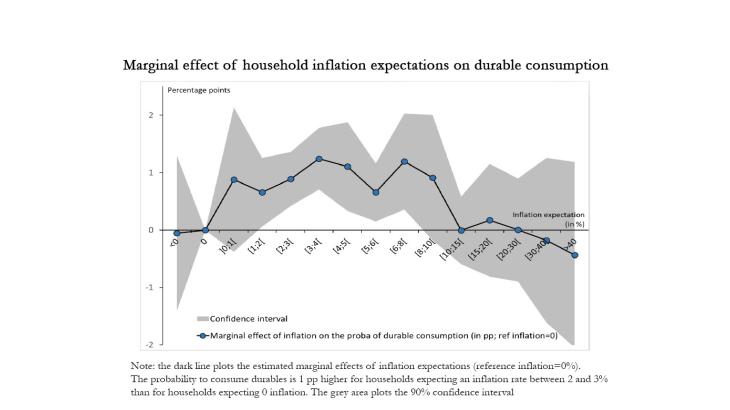Inflation expectations matter a great deal for central banks. They are considered both a measure of their credibility to achieve their price stability objective and a channel to manage current aggregate demand. However, how the inflation expectation channel operates in practice remains unclear when looking at these expectation data. In particular, households seem to be poorly informed about current and future inflation: they disagree strongly about it with a significant fraction of respondents having expectations that are far beyond the range of inflation realizations observed over the past years. This can question whether household inflation expectations really matter for their decisions and for the transmission of monetary policy. In this paper, we provide new evidence that what matters in households’ inflation expectations for their individual consumption decisions is the broad inflation regime -- rather than the precise inflation rate -- households expect.
We use individual data from a rich survey of French households covering about 2,000 individuals every month since January 2004. This survey provides detailed qualitative and quantitative information on both perceived and expected inflation, but also on households’ perceived and expected own and aggregate economic and financial situation, household’s durable consumption choices and socio-economic characteristics.
We first document four new facts on how households form their inflation expectations:
- A large share of households (more than 30%) expect prices to `stay about the same' over the next year.
- This share fluctuates a lot over time and consistently with realized inflation. In particular, we show that fluctuations in the share of households expecting positive inflation instead of stable prices – extensive margin -- accounts for nearly 75% of the variance of the average inflation expectation.
- The share of households expecting stable prices decreases when realized inflation declines. This correlation is stronger when realized inflation is low (below 2%).
- Households expecting positive inflation over the next year have a higher probability to buy new durable goods in the current year than households expecting that prices will remain stable over the same period (Figure A). By contrast, households with different positive inflation expectations have a similar propensity to buy durable goods over the current year. This finding holds true for various measures of durable consumption as used by the literature and for all types of households.
To obtain this connection between inflation expectations and consumption decisions, we emphasize the importance of controls. In particular, controlling for expected individual consumption and future business conditions matters to obtain a positive effect of expected inflation on durable consumption. The effect can otherwise be negative as several households expect more inflation to go with worse business conditions. Our results are robust to considering the short panel dimension of the survey and we also provide evidence of similar broad inflation regimes in a similar survey conducted in Germany and in the US Michigan survey.
Our findings have important implications for the use of inflation expectations for policy guidance. The large dispersion typically observed in the distribution of households’ inflation expectations does not mean these are uninformative: an important and informative component of this dispersion is the share of households expecting prices to remain stable. In addition, our findings have implications for macroeconomic policies. First, the ability to manage current aggregate demand by manipulating inflation expectations is more limited than in models where inflation expectations would react continuously to news. To be effective, forward guidance policies need to convince households to switch from stable prices regime to a positive inflation regime. Second, inflation expectations can de-anchor despite the average of inflation expectations remains positive and possibly high. This would happen when an important and stable share of households expect prices to remain about the same. This would put a persistent drag on current aggregate demand. Reanchoring will require to convince a substantial share of households that they should switch to a positive inflation regime. We illustrate these policy implications using a simple NK model with heterogeneous households’ beliefs.
